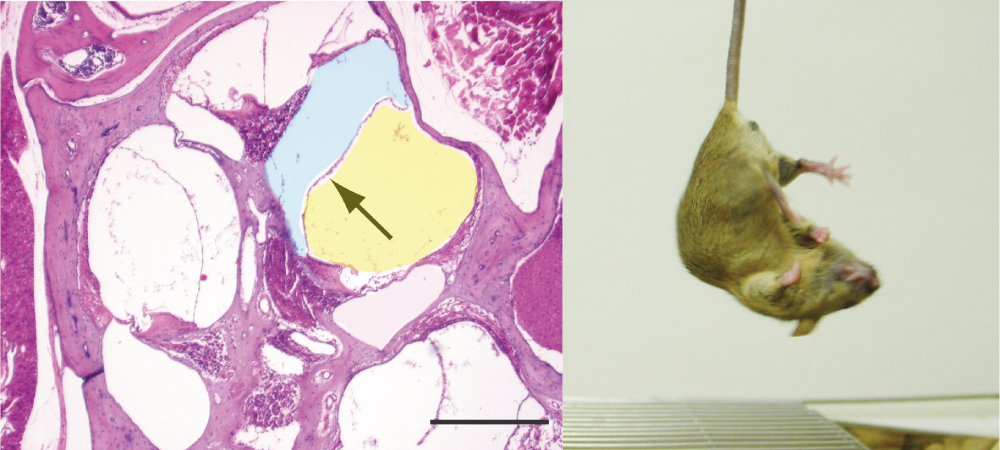May 2023 | Volume 24 No. 2
HKU Scientists Discover Deafness Master Genes
Our senses of hearing and balance are determined by the inner ear, which has six organs made up of sensory hair cells and the endolymphatic system whose fluid carries sound, gravity and linear acceleration signals to the brain. Defects in any of these can affect our hearing and balance. Professor Kathryn Cheah, Chair Professor of Biochemistry and Jimmy and Emily Tang Professor in Molecular Genetics, has done groundbreaking work to pinpoint genetic causes for these defects.
In 2005, while studying the development of the skeleton, she accidentally created a mouse model that was deaf and unable to balance. Her subsequent investigations led to the landmark discovery of a gene, SOX2, that controls the six sensing organs within the inner ear and is therefore a master gene essential for hearing.
But the identities of other master genes controlling the development of the endolymphatic system went largely undiscovered. Last year, however, Professor Cheah and her team reported two other master genes, SOX9 and SOX10, that play this role.
The latter discovery was also unexpected and arose from her work on campomelic dysplasia (CD), a rare and severe genetic disorder caused by mutation in the gene SOX9 that affects the development of a baby’s airway, lungs, bones and reproductive organs. Few babies survive birth so she and her team developed mouse models to study how the mutation causes CD in humans.
“Much to our surprise, we found that the mice were both deaf and had a vestibular problem,” she said. The vestibular function enables a person to balance themselves in space and is controlled from the inner ear. When there is a disturbance there, the mice are deaf and unable to balance.

Cross section of the inner ear in a normal mouse, which can balance itself and stretch to reach the ground when falling.

Swollen inner ear chambers are observed in SOX9 and SOX10 mutants which cannot balance themselves and are deaf.
Problem with fluid control
Professor Cheah and her team isolated the cause of the CD deafness to a problem in their endolymphatic system, which was very swollen, suggesting a problem with fluid control. Further investigation through both biochemistry and genetic investigations, with collaborators from HKU, The Chinese University of Hong Kong, the Francis Crick Institute in London and the University of Iowa, showed that genes controlled by SOX9 were causing the defect of the endolymphatic system.
“We discovered that SOX9 [of the same family as SOX2] is a master transcription factor that controls both how stem cells in the endolymphatic system develop and, at the molecular level, the expression of many genes that are important for producing the correct ionic composition in the endolymph fluid,” she said.
“What is even more interesting is that among the genes affected by the mutation was SOX10, which is another transcription factor and a sister gene of SOX9 belonging to the SOXE family. The mice deficient in SOX10 also had a similar problem with the endolymphatic system, implicating it as another master factor. We showed that SOX9 and SOX10 work together to control the development of stem cells for the endolymphatic system in the inner ear.”
Implications for common conditions
The finding has implications beyond the case of CD. Rare diseases are by definition severe, making it simpler to identify master genes that may also be related to more common conditions. Consider that one in 10 people is expected to experience hearing loss by 2050, that about one-to-three newborns per 1,000 born are hearing impaired with half of those cases due to genetic causes, and that malfunction in the ionic composition in the endolymph is the most common cause of deafness. Problems associated with a swollen endolymphatic system include deafness, vertigo and tinnitus (ringing in the ear).
“Our study reveals how the development of the normal ear is controlled and which genes are essential for the normal ear to be formed and for the correct composition of the endolymph. Since SOX9 and SOX10 are master genes controlling other genes, our study also provides a rich resource for discovering other candidate congenital deafness genes or identifying disease genes regulated by other SOXEgene factors,” Professor Cheah said. Ultimately, this can lead to new directions for developing treatments for hearing loss.
Professor Cheah and her team published their findings in the Proceedings of the National Academy of Sciences, together with a list of all the genes they found to be affected by the SOX9 mutation to help other researchers identify additional deafness genes. Her research could even aid in the study of age-related hearing loss, which may be caused by variants in other genes in the pool, by less severe mutations in the master genes or by a combination of other genes controlled by SOX9 and SOX10. The findings will also be useful for the future development of transplantable stem cells and/or artificial organs or tissues as regenerative medicine for hearing loss.
Our study reveals how the development of the normal ear is controlled and which genes are essential for the normal ear to be formed and for the correct composition of the endolymph.

PROFESSOR KATHRYN CHEAH

